LIN8001 Module 1: Crosslinguistic Influence and Cognitive Processes
VerifiedAdded on 2022/08/23
|6
|1460
|17
Discussion Board Post
AI Summary
This discussion post explores two key concepts: crosslinguistic influence and cognition. The first part defines crosslinguistic influence as the impact one language has on another in bilingual speakers, examining stages of language acquisition and language transfer, including positive and negative effects, and the role of the dominant language. The second part delves into cognition, defining it as thinking and exploring its application in various aspects of human life, including attention, memory, and decision-making. It contrasts fast and slow thinking, discusses cognitive biases, and highlights the role of metacognition in self-awareness and managing cognitive processes. The post references various academic sources to support its arguments, providing a comprehensive overview of these interconnected concepts.
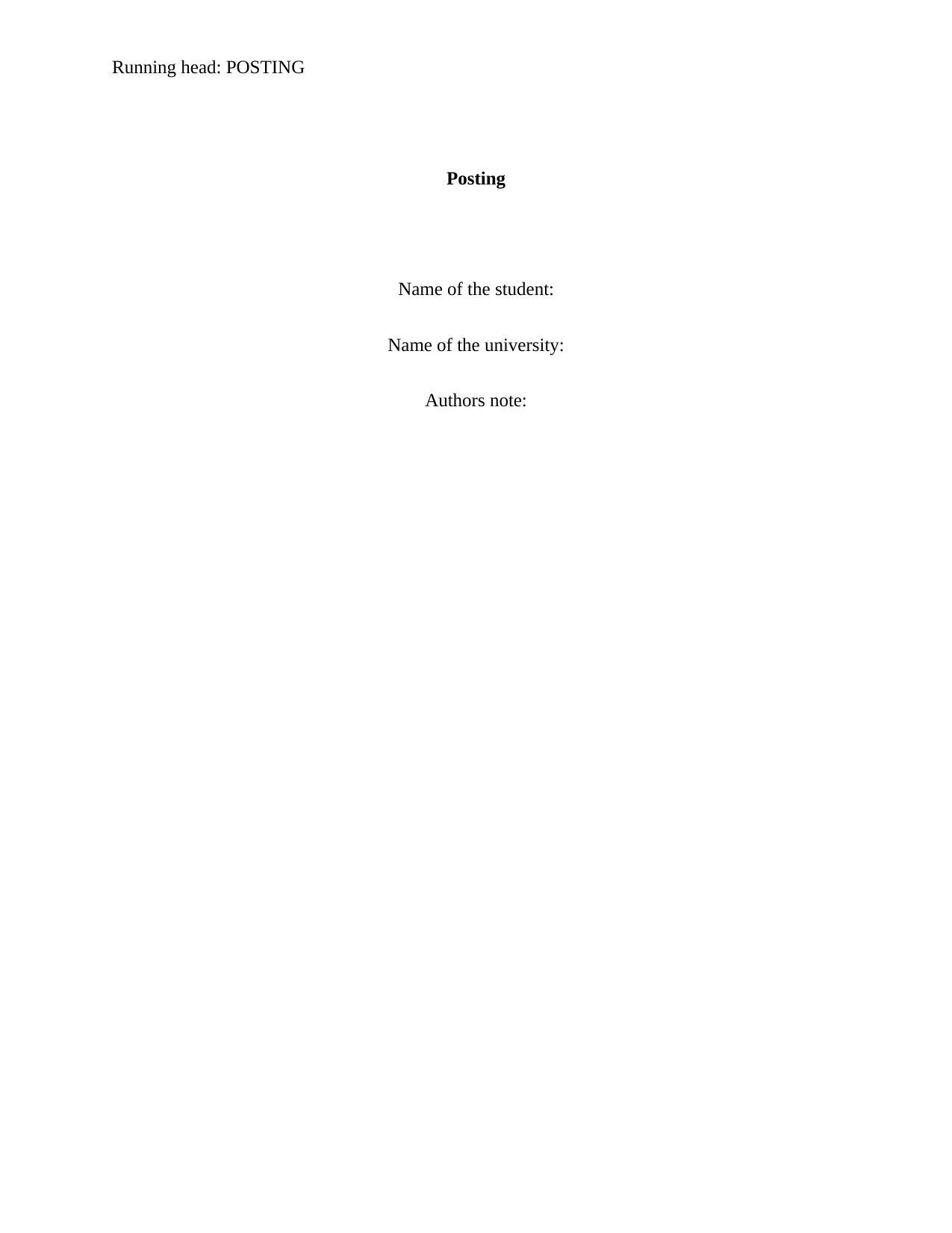
Running head: POSTING
Posting
Name of the student:
Name of the university:
Authors note:
Posting
Name of the student:
Name of the university:
Authors note:
Paraphrase This Document
Need a fresh take? Get an instant paraphrase of this document with our AI Paraphraser
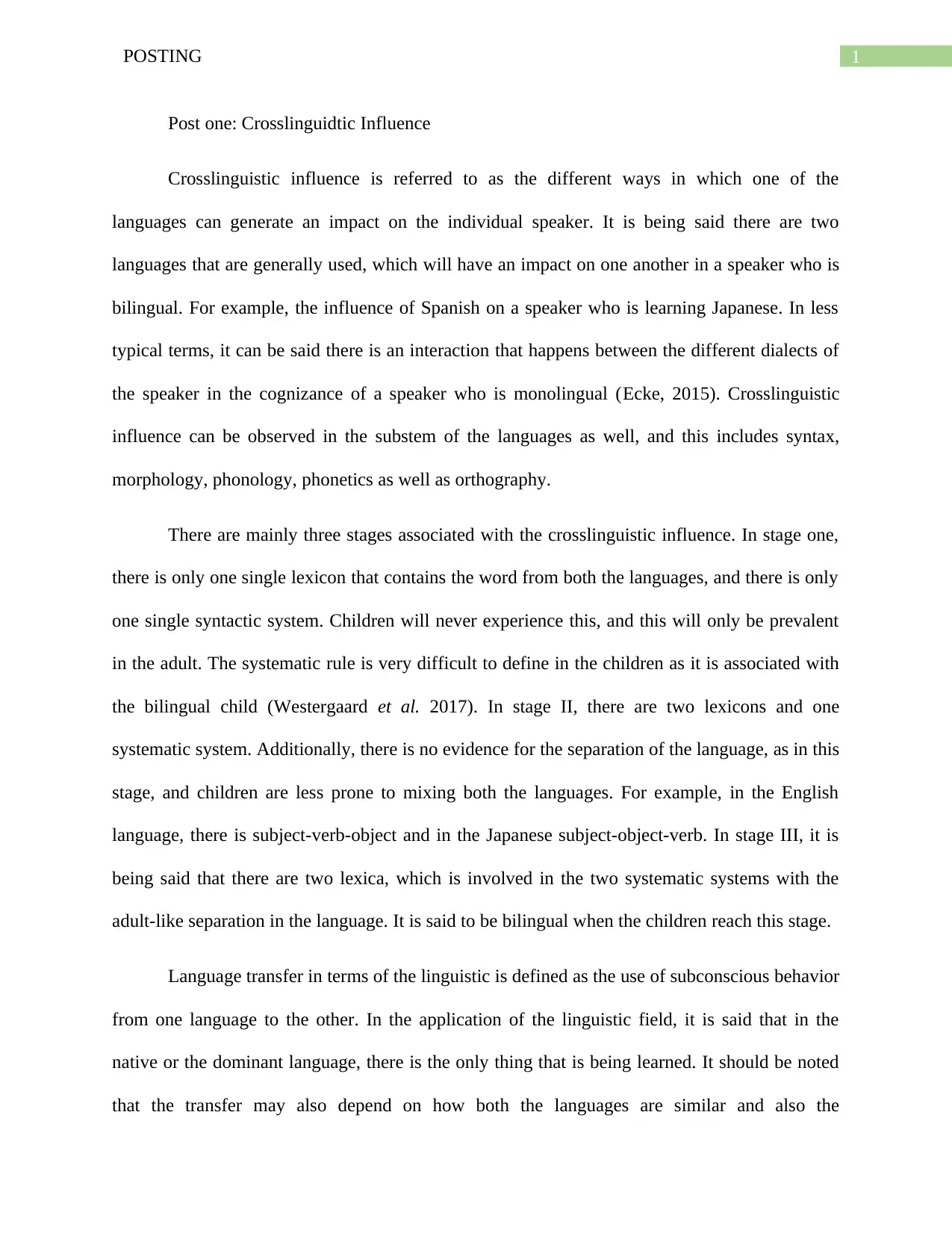
1POSTING
Post one: Crosslinguidtic Influence
Crosslinguistic influence is referred to as the different ways in which one of the
languages can generate an impact on the individual speaker. It is being said there are two
languages that are generally used, which will have an impact on one another in a speaker who is
bilingual. For example, the influence of Spanish on a speaker who is learning Japanese. In less
typical terms, it can be said there is an interaction that happens between the different dialects of
the speaker in the cognizance of a speaker who is monolingual (Ecke, 2015). Crosslinguistic
influence can be observed in the substem of the languages as well, and this includes syntax,
morphology, phonology, phonetics as well as orthography.
There are mainly three stages associated with the crosslinguistic influence. In stage one,
there is only one single lexicon that contains the word from both the languages, and there is only
one single syntactic system. Children will never experience this, and this will only be prevalent
in the adult. The systematic rule is very difficult to define in the children as it is associated with
the bilingual child (Westergaard et al. 2017). In stage II, there are two lexicons and one
systematic system. Additionally, there is no evidence for the separation of the language, as in this
stage, and children are less prone to mixing both the languages. For example, in the English
language, there is subject-verb-object and in the Japanese subject-object-verb. In stage III, it is
being said that there are two lexica, which is involved in the two systematic systems with the
adult-like separation in the language. It is said to be bilingual when the children reach this stage.
Language transfer in terms of the linguistic is defined as the use of subconscious behavior
from one language to the other. In the application of the linguistic field, it is said that in the
native or the dominant language, there is the only thing that is being learned. It should be noted
that the transfer may also depend on how both the languages are similar and also the
Post one: Crosslinguidtic Influence
Crosslinguistic influence is referred to as the different ways in which one of the
languages can generate an impact on the individual speaker. It is being said there are two
languages that are generally used, which will have an impact on one another in a speaker who is
bilingual. For example, the influence of Spanish on a speaker who is learning Japanese. In less
typical terms, it can be said there is an interaction that happens between the different dialects of
the speaker in the cognizance of a speaker who is monolingual (Ecke, 2015). Crosslinguistic
influence can be observed in the substem of the languages as well, and this includes syntax,
morphology, phonology, phonetics as well as orthography.
There are mainly three stages associated with the crosslinguistic influence. In stage one,
there is only one single lexicon that contains the word from both the languages, and there is only
one single syntactic system. Children will never experience this, and this will only be prevalent
in the adult. The systematic rule is very difficult to define in the children as it is associated with
the bilingual child (Westergaard et al. 2017). In stage II, there are two lexicons and one
systematic system. Additionally, there is no evidence for the separation of the language, as in this
stage, and children are less prone to mixing both the languages. For example, in the English
language, there is subject-verb-object and in the Japanese subject-object-verb. In stage III, it is
being said that there are two lexica, which is involved in the two systematic systems with the
adult-like separation in the language. It is said to be bilingual when the children reach this stage.
Language transfer in terms of the linguistic is defined as the use of subconscious behavior
from one language to the other. In the application of the linguistic field, it is said that in the
native or the dominant language, there is the only thing that is being learned. It should be noted
that the transfer may also depend on how both the languages are similar and also the
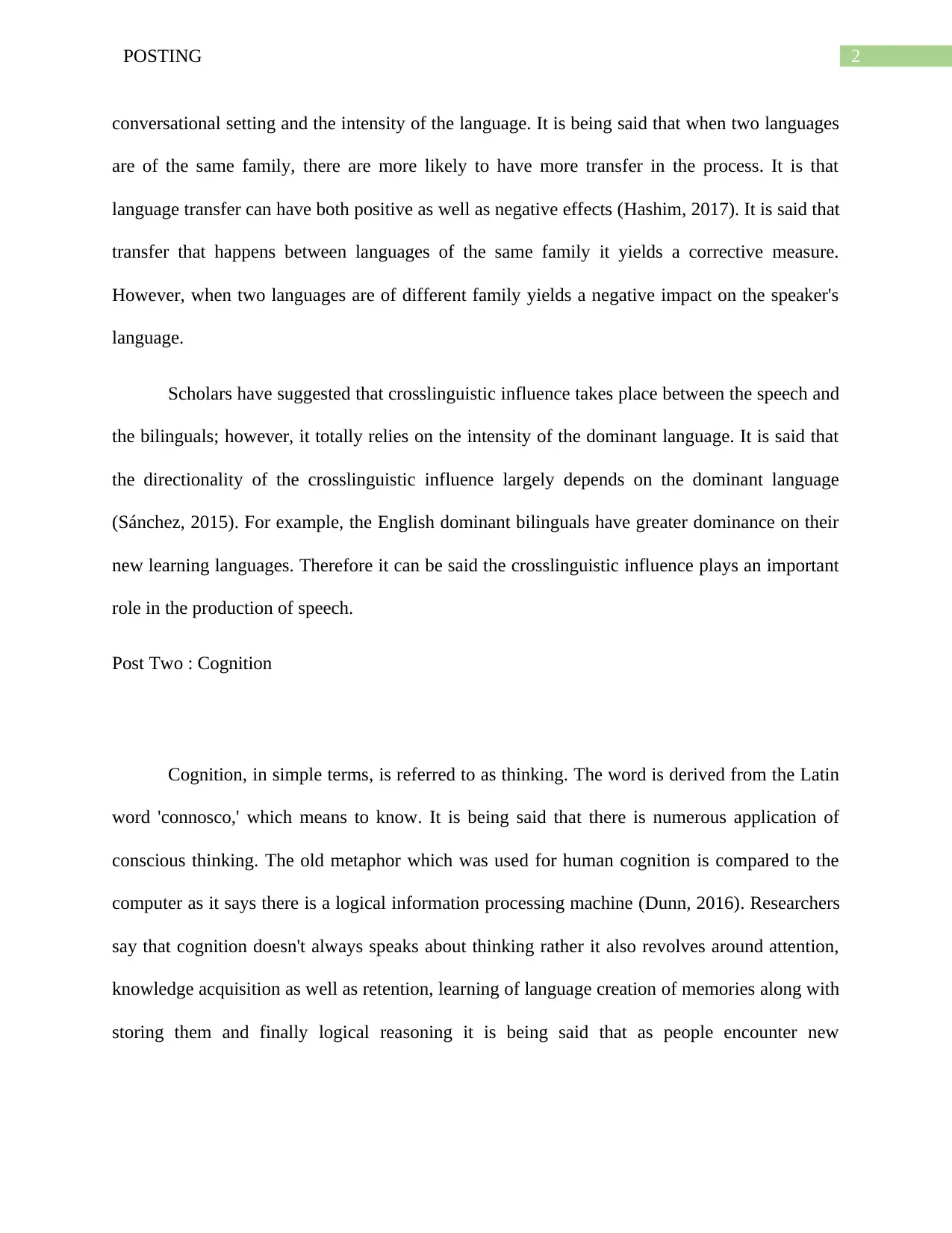
2POSTING
conversational setting and the intensity of the language. It is being said that when two languages
are of the same family, there are more likely to have more transfer in the process. It is that
language transfer can have both positive as well as negative effects (Hashim, 2017). It is said that
transfer that happens between languages of the same family it yields a corrective measure.
However, when two languages are of different family yields a negative impact on the speaker's
language.
Scholars have suggested that crosslinguistic influence takes place between the speech and
the bilinguals; however, it totally relies on the intensity of the dominant language. It is said that
the directionality of the crosslinguistic influence largely depends on the dominant language
(Sánchez, 2015). For example, the English dominant bilinguals have greater dominance on their
new learning languages. Therefore it can be said the crosslinguistic influence plays an important
role in the production of speech.
Post Two : Cognition
Cognition, in simple terms, is referred to as thinking. The word is derived from the Latin
word 'connosco,' which means to know. It is being said that there is numerous application of
conscious thinking. The old metaphor which was used for human cognition is compared to the
computer as it says there is a logical information processing machine (Dunn, 2016). Researchers
say that cognition doesn't always speaks about thinking rather it also revolves around attention,
knowledge acquisition as well as retention, learning of language creation of memories along with
storing them and finally logical reasoning it is being said that as people encounter new
conversational setting and the intensity of the language. It is being said that when two languages
are of the same family, there are more likely to have more transfer in the process. It is that
language transfer can have both positive as well as negative effects (Hashim, 2017). It is said that
transfer that happens between languages of the same family it yields a corrective measure.
However, when two languages are of different family yields a negative impact on the speaker's
language.
Scholars have suggested that crosslinguistic influence takes place between the speech and
the bilinguals; however, it totally relies on the intensity of the dominant language. It is said that
the directionality of the crosslinguistic influence largely depends on the dominant language
(Sánchez, 2015). For example, the English dominant bilinguals have greater dominance on their
new learning languages. Therefore it can be said the crosslinguistic influence plays an important
role in the production of speech.
Post Two : Cognition
Cognition, in simple terms, is referred to as thinking. The word is derived from the Latin
word 'connosco,' which means to know. It is being said that there is numerous application of
conscious thinking. The old metaphor which was used for human cognition is compared to the
computer as it says there is a logical information processing machine (Dunn, 2016). Researchers
say that cognition doesn't always speaks about thinking rather it also revolves around attention,
knowledge acquisition as well as retention, learning of language creation of memories along with
storing them and finally logical reasoning it is being said that as people encounter new
⊘ This is a preview!⊘
Do you want full access?
Subscribe today to unlock all pages.

Trusted by 1+ million students worldwide
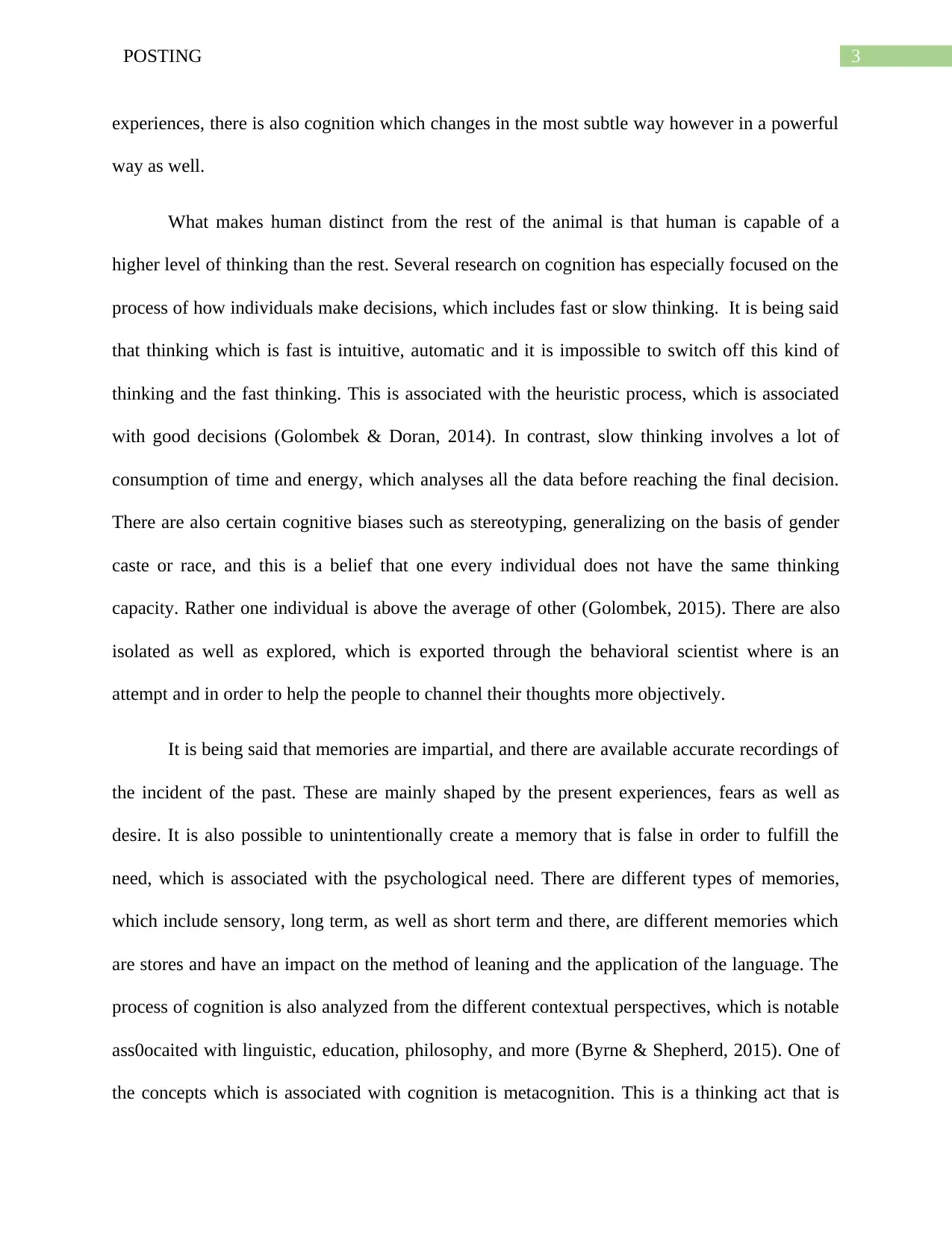
3POSTING
experiences, there is also cognition which changes in the most subtle way however in a powerful
way as well.
What makes human distinct from the rest of the animal is that human is capable of a
higher level of thinking than the rest. Several research on cognition has especially focused on the
process of how individuals make decisions, which includes fast or slow thinking. It is being said
that thinking which is fast is intuitive, automatic and it is impossible to switch off this kind of
thinking and the fast thinking. This is associated with the heuristic process, which is associated
with good decisions (Golombek & Doran, 2014). In contrast, slow thinking involves a lot of
consumption of time and energy, which analyses all the data before reaching the final decision.
There are also certain cognitive biases such as stereotyping, generalizing on the basis of gender
caste or race, and this is a belief that one every individual does not have the same thinking
capacity. Rather one individual is above the average of other (Golombek, 2015). There are also
isolated as well as explored, which is exported through the behavioral scientist where is an
attempt and in order to help the people to channel their thoughts more objectively.
It is being said that memories are impartial, and there are available accurate recordings of
the incident of the past. These are mainly shaped by the present experiences, fears as well as
desire. It is also possible to unintentionally create a memory that is false in order to fulfill the
need, which is associated with the psychological need. There are different types of memories,
which include sensory, long term, as well as short term and there, are different memories which
are stores and have an impact on the method of leaning and the application of the language. The
process of cognition is also analyzed from the different contextual perspectives, which is notable
ass0ocaited with linguistic, education, philosophy, and more (Byrne & Shepherd, 2015). One of
the concepts which is associated with cognition is metacognition. This is a thinking act that is
experiences, there is also cognition which changes in the most subtle way however in a powerful
way as well.
What makes human distinct from the rest of the animal is that human is capable of a
higher level of thinking than the rest. Several research on cognition has especially focused on the
process of how individuals make decisions, which includes fast or slow thinking. It is being said
that thinking which is fast is intuitive, automatic and it is impossible to switch off this kind of
thinking and the fast thinking. This is associated with the heuristic process, which is associated
with good decisions (Golombek & Doran, 2014). In contrast, slow thinking involves a lot of
consumption of time and energy, which analyses all the data before reaching the final decision.
There are also certain cognitive biases such as stereotyping, generalizing on the basis of gender
caste or race, and this is a belief that one every individual does not have the same thinking
capacity. Rather one individual is above the average of other (Golombek, 2015). There are also
isolated as well as explored, which is exported through the behavioral scientist where is an
attempt and in order to help the people to channel their thoughts more objectively.
It is being said that memories are impartial, and there are available accurate recordings of
the incident of the past. These are mainly shaped by the present experiences, fears as well as
desire. It is also possible to unintentionally create a memory that is false in order to fulfill the
need, which is associated with the psychological need. There are different types of memories,
which include sensory, long term, as well as short term and there, are different memories which
are stores and have an impact on the method of leaning and the application of the language. The
process of cognition is also analyzed from the different contextual perspectives, which is notable
ass0ocaited with linguistic, education, philosophy, and more (Byrne & Shepherd, 2015). One of
the concepts which is associated with cognition is metacognition. This is a thinking act that is
Paraphrase This Document
Need a fresh take? Get an instant paraphrase of this document with our AI Paraphraser

4POSTING
related to the individual mental process. This, in turn, creates awareness among the people in
order to identify, uproot the negative self-talk, monitor as well s self-limiting beliefs. It is also
associated with weight the challenges of individualistic thinking, which is in the type of therapy.
This is also included in the CBT.
related to the individual mental process. This, in turn, creates awareness among the people in
order to identify, uproot the negative self-talk, monitor as well s self-limiting beliefs. It is also
associated with weight the challenges of individualistic thinking, which is in the type of therapy.
This is also included in the CBT.
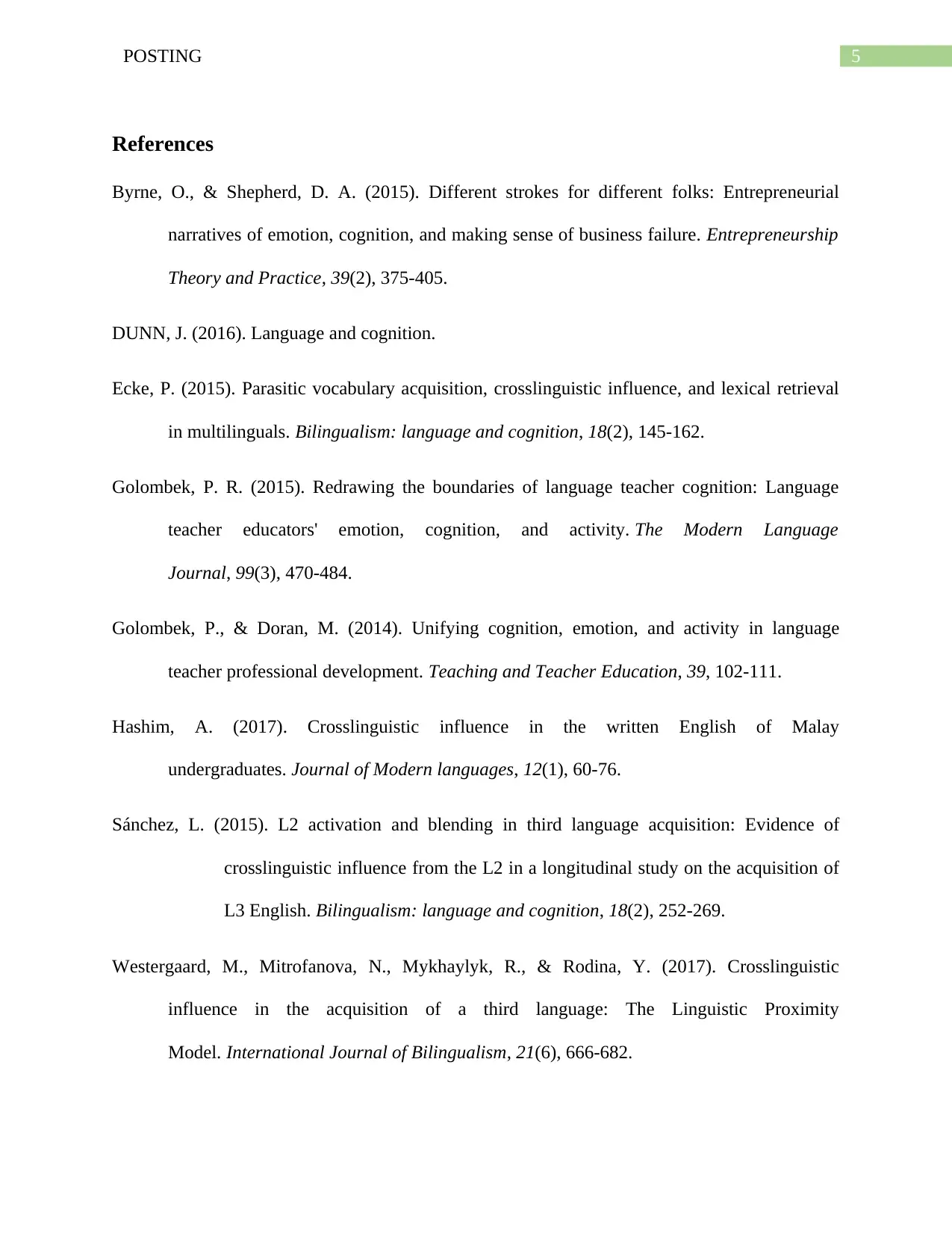
5POSTING
References
Byrne, O., & Shepherd, D. A. (2015). Different strokes for different folks: Entrepreneurial
narratives of emotion, cognition, and making sense of business failure. Entrepreneurship
Theory and Practice, 39(2), 375-405.
DUNN, J. (2016). Language and cognition.
Ecke, P. (2015). Parasitic vocabulary acquisition, crosslinguistic influence, and lexical retrieval
in multilinguals. Bilingualism: language and cognition, 18(2), 145-162.
Golombek, P. R. (2015). Redrawing the boundaries of language teacher cognition: Language
teacher educators' emotion, cognition, and activity. The Modern Language
Journal, 99(3), 470-484.
Golombek, P., & Doran, M. (2014). Unifying cognition, emotion, and activity in language
teacher professional development. Teaching and Teacher Education, 39, 102-111.
Hashim, A. (2017). Crosslinguistic influence in the written English of Malay
undergraduates. Journal of Modern languages, 12(1), 60-76.
Sánchez, L. (2015). L2 activation and blending in third language acquisition: Evidence of
crosslinguistic influence from the L2 in a longitudinal study on the acquisition of
L3 English. Bilingualism: language and cognition, 18(2), 252-269.
Westergaard, M., Mitrofanova, N., Mykhaylyk, R., & Rodina, Y. (2017). Crosslinguistic
influence in the acquisition of a third language: The Linguistic Proximity
Model. International Journal of Bilingualism, 21(6), 666-682.
References
Byrne, O., & Shepherd, D. A. (2015). Different strokes for different folks: Entrepreneurial
narratives of emotion, cognition, and making sense of business failure. Entrepreneurship
Theory and Practice, 39(2), 375-405.
DUNN, J. (2016). Language and cognition.
Ecke, P. (2015). Parasitic vocabulary acquisition, crosslinguistic influence, and lexical retrieval
in multilinguals. Bilingualism: language and cognition, 18(2), 145-162.
Golombek, P. R. (2015). Redrawing the boundaries of language teacher cognition: Language
teacher educators' emotion, cognition, and activity. The Modern Language
Journal, 99(3), 470-484.
Golombek, P., & Doran, M. (2014). Unifying cognition, emotion, and activity in language
teacher professional development. Teaching and Teacher Education, 39, 102-111.
Hashim, A. (2017). Crosslinguistic influence in the written English of Malay
undergraduates. Journal of Modern languages, 12(1), 60-76.
Sánchez, L. (2015). L2 activation and blending in third language acquisition: Evidence of
crosslinguistic influence from the L2 in a longitudinal study on the acquisition of
L3 English. Bilingualism: language and cognition, 18(2), 252-269.
Westergaard, M., Mitrofanova, N., Mykhaylyk, R., & Rodina, Y. (2017). Crosslinguistic
influence in the acquisition of a third language: The Linguistic Proximity
Model. International Journal of Bilingualism, 21(6), 666-682.
⊘ This is a preview!⊘
Do you want full access?
Subscribe today to unlock all pages.

Trusted by 1+ million students worldwide
1 out of 6
Your All-in-One AI-Powered Toolkit for Academic Success.
+13062052269
info@desklib.com
Available 24*7 on WhatsApp / Email
![[object Object]](/_next/static/media/star-bottom.7253800d.svg)
Unlock your academic potential
Copyright © 2020–2025 A2Z Services. All Rights Reserved. Developed and managed by ZUCOL.
